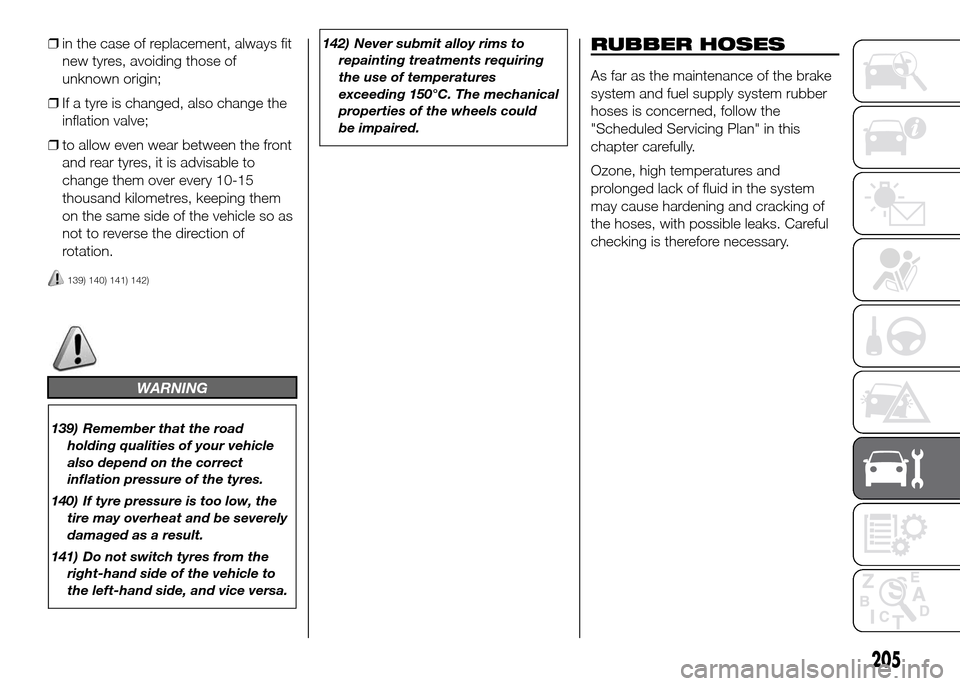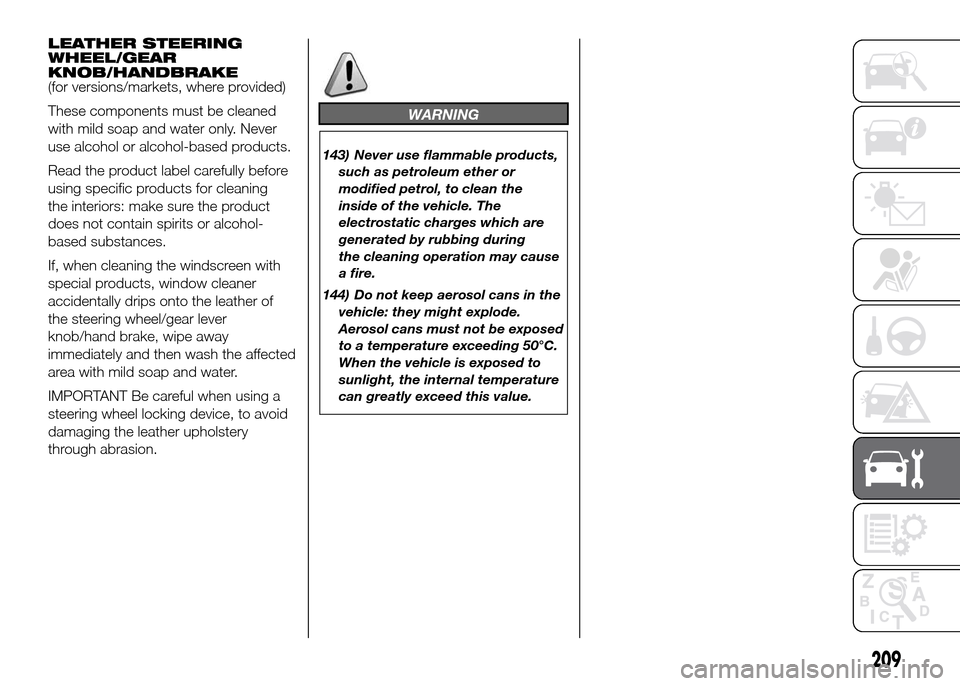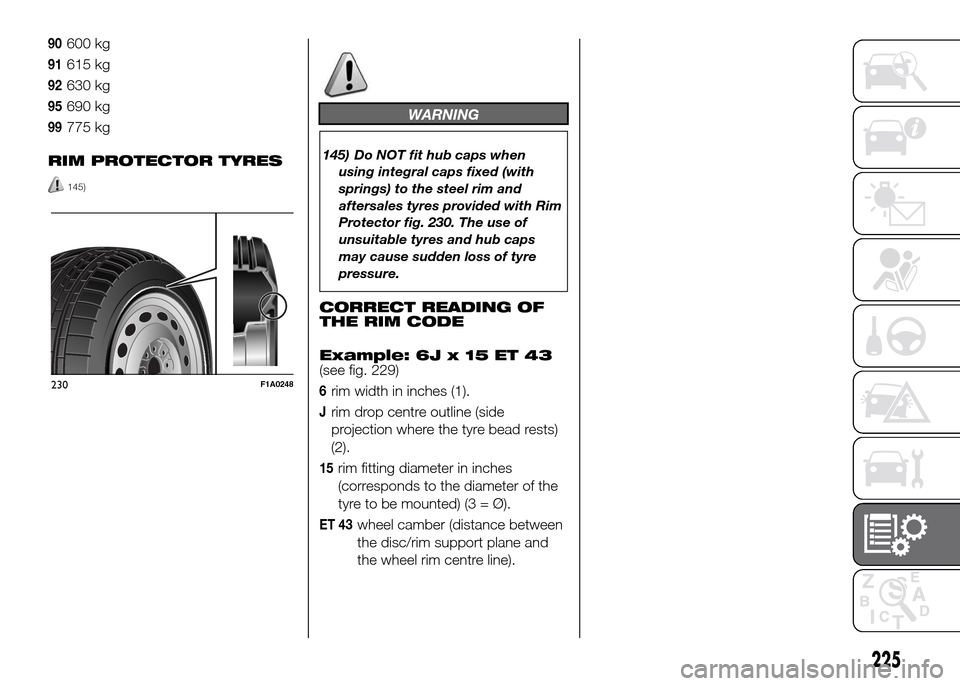2016 FIAT DOBLO PANORAMA warning
[x] Cancel search: warningPage 203 of 323

DIESEL FILTER
DRAINING
CONDENSATION
(MultiJet versions)
36)
IMPORTANT
36) The presence of water in the
supply circuit may cause severe
damage to the injection system
and irregular engine operation. If
the
warning light comes on,
go to a Fiat Dealership as soon as
possible to have the system bled.
If this problem is indicated
immediately after refuelling, water
may have entered the fuel tank.
In this case, immediately turn off
the engine and contact a Fiat
Dealership.
BATTERY
The battery is of the “limited
maintenance” type: under normal
conditions of use, the electrolyte does
not need topping up with distilled water.
It does, however, need to be checked
periodically at a Fiat Dealership or
by specialist personnel to make sure it
is working correctly.
133) 134)
REPLACING THE
BATTERY
If required, replace the battery with an
original spare part with the same
specifications.
If a battery with different specifications
is fitted, the service intervals given in
the “Scheduled Servicing Plan” will no
longer be valid.
Follow the battery manufacturer's
instructions for maintenance.
37) 38)
5)
135)
USEFUL TIPS FOR
EXTENDING BATTERY
LIFE
To avoid draining your battery and
make it last longer, observe the
following instructions:
❒when you park the vehicle, ensure
that the doors, tailgate and bonnet
are closed properly, to prevent any
roof lights from remaining on inside
the passenger's compartment;
❒switch off all roof lights inside the
vehicle: the vehicle is however
equipped with a system which
switches all internal lights off
automatically;
❒do not keep accessories (e.g. radio,
hazard warning lights, etc.) switched
on for a long time when the engine
is not running;
❒before performing any operation on
the electrical system, disconnect
the negative battery pole;
❒completely tighten the battery
terminals.
IMPORTANT If the charge level remains
under 50% for a long time, the battery
is damaged by sulphation, reducing
its capacity and efficiency at starting.
199
Page 204 of 323

The battery is also more prone to the
risk of freezing (already at temperatures
of -10°C). Refer to the paragraph
"Vehicle inactivity" in "Starting and
driving" if the vehicle is left parked for a
long time.
If, after buying the vehicle, you want to
install electric accessories which require
permanent electric supply (alarm, etc.)
contact a Fiat Dealership whose
qualified personnel, in addition to
suggesting the most suitable devices
from the Lineaccessori Fiat, will
evaluate the overall electric absorption,
checking whether the vehicle's
electrical system is capable of
withstanding the load required, or
whether it should be integrated with a
more powerful battery.
Since some of these devices continue
to consume electricity even when
the engine is off, they gradually run
down the battery.
WARNING
133) Battery fluid is poisonous and
corrosive. Avoid contact with
skin and eyes. Keep naked flames
or possible sources of sparks
away from the battery: risk
of explosion or fire.
134) Using the battery when the fluid
is too low can damage it
irreparably and generate a risk of
explosion.
135) When performing any operation
on the battery or near it, always
protect your eyes with special
goggles.
IMPORTANT
37) Incorrect assembly of electrical
and electronic devices may cause
severe damage to your vehicle.
Contact a Fiat Dealership if you
want to install accessories
(alarms, radiophone, etc.): they
will suggest the most suitable
devices and advise you if a higher
capacity battery needs to be
installed.
38) If the vehicle needs to be off the
road for a long period under
conditions of intense cold, remove
the battery and take it to a
heated location, otherwise it may
freeze.
200
SERVICING AND MAINTENANCE
Page 206 of 323

❒after disconnecting the battery
charger, reconnect the quick-release
negative terminal A to the dummy
pole B.
Versions without dummy pole fig.
219
To recharge proceed as follows, paying
great care:
❒press button A to detach connector
B from battery status monitoring
sensor C (this is located on the
negative pole of the battery itself);
❒connect the positive cable (+) of the
battery charger to the battery positive
terminal (+);
❒connect the negative cable (–) of the
battery charger to the pin D of the
negative battery terminal (–);
❒turn on the charger;❒when you have finished, turn the
charger off before disconnecting
it from the battery;
❒reconnect the connector B to the
sensor C of the battery.
136) 137)
WARNING
136) Battery fluid is poisonous and
corrosive: avoid contact with
your skin and eyes. The battery
recharging operation must be
performed in a ventilated place,
away from naked flames or
possible sources of sparks to
avoid the risk of explosion and
fire.
137) Don't try to recharge a frozen
battery: it must be thawed first,
otherwise it may explode. If the
battery was frozen, have it
inspected by specialised
personnel before recharging to
check that the internal elements
are not damaged and that the
casing is not cracked, which
causes the risk of leakage
of poisonous, corrosive acid.
WINDSCREEN/REAR
WINDOW WIPER
(for versions/markets, where provided)
BLADES
Periodically clean the rubber part using
special products; TUTELA
PROFESSIONAL SC 35 is
recommended.
Replace the blades if the rubber edge is
deformed or worn. In any case, it is
advisable to replace them
approximately once a year.
A few simple precautions can reduce
the possibility of damage to the blades:
❒if the temperature falls below zero,
make sure that ice has not frozen
the rubber against the glass. Use a
de-icing product to release it if
required;
❒remove any snow from the glass: in
addition to protecting the blades,
this prevents effort on the motor and
overheating;
❒do not operate the windscreen and
rear window wipers on dry glass.
138)
219F0V0380
202
SERVICING AND MAINTENANCE
Page 208 of 323

Rear window (washer)
The rear window washer jets are fixed.
The nozzle holder is located above
the rear window.
WARNING
138) Driving with worn windscreen
wiper blades is a serious hazard,
because visibility is reduced in
bad weather conditions.
WHEELS AND TYRES
Check the pressure of each tyre,
including the space-saver wheel,
approximately every two weeks and
before long journeys: the pressure
should be checked with the tyre rested
and cold.
It is normal for the pressure to increase
when the vehicle is used; for the correct
tyre inflation pressure, see “Wheels” in
the “Technical specifications” section.
Incorrect pressure causes abnormal
tyre wear fig. 224:
Anormal pressure: tread evenly worn;
Blow pressure: tread particularly worn
at the edges;
Chigh pressure: tread particularly worn
in the centre.The tyres must be replaced when the
tread is less than 1.6 mm thick. In
any case, follow the laws in force in the
country you are in.
IMPORTANT
❒As far as possible, avoid sharp
braking, screech starts and violent
shocks against pavements, potholes
or other hard obstacles. Driving for
long stretches over bumpy roads can
damage the tyres;
❒periodically check that the tyres have
no cuts in the side wall, abnormal
swelling or irregular tyre wear.
Contact a Fiat Dealership if required;
❒avoid overloading the vehicle when
travelling: this may cause serious
damage to the wheels and tyres;
❒if a tyre is punctured, stop
immediately and change it to avoid
damage to the tyre, the rim,
suspensions and steering system;
❒tyres age even if they are not used
much. Cracks in the tread and on
the side walls are a sign of ageing.
Have the tyres checked by
specialised personnel if they have
been fitted for longer than 6 years.
Remember to check the spare wheel
very carefully;
224F0V0161
204
SERVICING AND MAINTENANCE
Page 209 of 323

❒in the case of replacement, always fit
new tyres, avoiding those of
unknown origin;
❒If a tyre is changed, also change the
inflation valve;
❒to allow even wear between the front
and rear tyres, it is advisable to
change them over every 10-15
thousand kilometres, keeping them
on the same side of the vehicle so as
not to reverse the direction of
rotation.
139) 140) 141) 142)
WARNING
139) Remember that the road
holding qualities of your vehicle
also depend on the correct
inflation pressure of the tyres.
140) If tyre pressure is too low, the
tire may overheat and be severely
damaged as a result.
141) Do not switch tyres from the
righthand side of the vehicle to
the lefthand side, and vice versa.142) Never submit alloy rims to
repainting treatments requiring
the use of temperatures
exceeding 150°C. The mechanical
properties of the wheels could
be impaired.
RUBBER HOSES
As far as the maintenance of the brake
system and fuel supply system rubber
hoses is concerned, follow the
"Scheduled Servicing Plan" in this
chapter carefully.
Ozone, high temperatures and
prolonged lack of fluid in the system
may cause hardening and cracking of
the hoses, with possible leaks. Careful
checking is therefore necessary.
205
Page 213 of 323

LEATHER STEERING
WHEEL/GEAR
KNOB/HANDBRAKE
(for versions/markets, where provided)
These components must be cleaned
with mild soap and water only. Never
use alcohol or alcohol-based products.
Read the product label carefully before
using specific products for cleaning
the interiors: make sure the product
does not contain spirits or alcohol-
based substances.
If, when cleaning the windscreen with
special products, window cleaner
accidentally drips onto the leather of
the steering wheel/gear lever
knob/hand brake, wipe away
immediately and then wash the affected
area with mild soap and water.
IMPORTANT Be careful when using a
steering wheel locking device, to avoid
damaging the leather upholstery
through abrasion.
WARNING
143) Never use flammable products,
such as petroleum ether or
modified petrol, to clean the
inside of the vehicle. The
electrostatic charges which are
generated by rubbing during
the cleaning operation may cause
a fire.
144) Do not keep aerosol cans in the
vehicle: they might explode.
Aerosol cans must not be exposed
to a temperature exceeding 50°C.
When the vehicle is exposed to
sunlight, the internal temperature
can greatly exceed this value.
209
Page 229 of 323

90600 kg
91615 kg
92630 kg
95690 kg
99775 kg
RIM PROTECTOR TYRES
145)
WARNING
145) Do NOT fit hub caps when
using integral caps fixed (with
springs) to the steel rim and
aftersales tyres provided with Rim
Protector fig. 230. The use of
unsuitable tyres and hub caps
may cause sudden loss of tyre
pressure.
CORRECT READING OF
THE RIM CODE
Example: 6J x 15 ET 43
(see fig. 229)
6rim width in inches (1).
Jrim drop centre outline (side
projection where the tyre bead rests)
(2).
15rim fitting diameter in inches
(corresponds to the diameter of the
tyre to be mounted) (3 = Ø).
ET 43wheel camber (distance between
the disc/rim support plane and
the wheel rim centre line).
230F1A0248
225
Page 320 of 323

Hazard warning lights..................... 152
Headlights...................................... 66
Headlight washers ......................... 40
Head restraints............................... 30
Heating and ventilation ............... 41-43
Hill Holder system .......................... 108
Identification data .......................... 212
Ignition device ................................ 16
Important information ..................... 126
Inflation pressure ............................ 230
Installing electrical/electronic
devices ........................................ 5
Interior fittings ................................ 62
Interior lights .................................. 36
Interior mirror ................................. 32
Interiors .......................................... 208
Isofix child restraint system
setup ........................................... 119
Jump starting ................................ 174
Lifting the vehicle .......................... 176
Load limiters .................................. 113
Luggage compartment light ........... 37
Main beam headlights............. 34-156
Maintenance of the seat belts ........ 114
Manual climate control system ....... 45
Manual deactivation of
passenger side front airbag and
side bag for chest/head
protection .................................... 123
MSR system .................................. 109Multifunction display....................... 78
– Control buttons ......................... 78
– Set-up menu ............................. 79
Number plate lights (for
hatchback versions) ..................... 158
Number plate lights (for versions
with wing doors)........................... 158
Occupant protection systems ....... 110
Parking ......................................... 132
Parking sensors ............................. 144
Partitions........................................ 28
Passenger side front airbag ............ 122
Performance .................................. 269
Periodic checks ............................. 188
Plastic parts ................................... 208
Plugs (type) .................................... 216
Power socket ................................. 62
Power steering fluid........................ 197
Practical advice for reducing fuel
consumption and harmful
emissions ..................................... 147
Prescriptions for vehicle at end
of life ............................................ 305
Pretensioners ................................. 113
Procedure for diesel versions ......... 130
Procedure for petrol versions.......... 130
Prolonged vehicle inactivity............. 206
Protecting the environment ............ 68
Protection against atmospheric
agents.......................................... 206
Radio (setup) ................................ 67
Radio transmitters and mobile
phones......................................... 5
Rear doors ..................................... 21
Rear fog lights ................................ 57
Rear light clusters .......................... 156
Rear roof light ................................ 159
Rear view mirrors ........................... 32
Rear window washer...................... 40
Rear window wiper ..................... 39-40
Refuelling the vehicle ...................... 146
Replacing a bulb ............................ 152
Replacing an exterior bulb .............. 155
Replacing an interior bulb ............... 158
Replacing fuses.............................. 160
Replacing the battery ..................... 199
Rim Protector................................. 225
Rims and tyres ............................... 224
Roof rack ....................................... 66
Rubber hoses ................................ 205
Saving fuel .................................... 147
SBR system ................................... 112
Scheduled servicing ....................... 180
Scheduled Servicing Plan ............... 181
Seat belts....................................... 111
Seats and fabric parts .................... 208
Seats ............................................. 23
– Driver’s seat .............................. 23
– Passenger seat ......................... 24
INDEX